|
Mai Cheng Zheng: Ancient signs,
Feng-shui Art |
||||
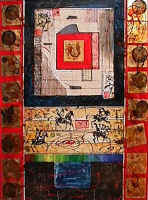 |
The Chinese born artist Mai Cheng Zheng cultivates our fascination with things which seem old and distant. Under the surface of her paintings, which are partly scraped down to reveal the layers that are underneath, you may find unknown stamps and characters from remote cultures. Calligraphy has always characterized Mai Cheng Zheng’s paintings, while Nordic runes and rock carvings have inspired her since she moved to Norway in 1984. From 1994 she started spending the winter time in Egypt (she has so far been there six times), visiting old temples and studying hieroglyphic writings. She has also traveled around Mexico and in different parts of Asia in order to study ancient signs and calligraphy. In her art this has resulted in a kind of esthetic archaeology with traces of history shining like a hidden message through the surface. It is as if the unconsciousness of her paintings brings us from the sign language of ancient cultures all the way back to the prehistoric cave paintings and the archetypes which constitute our common heritage. Under several layers of history there are traces of symbols and words that have disappeared from languages which seem expelled to inscriptions on rocks or in clay, words that appear strangely powerful even though we may be unable to interpret them. -I try to make the signs communicate in a way that emphasize their common source, says Mai Cheng Zheng. -When I work with this material, I discover junctions between cultures that have been separated both historically and geographically. I base my work on the fact that the esthetic which characterized the "writing" of our ancestors is common to humankind and therefore is perceived as archetypes to modern people. In the beginning was the word... a picture A picture says more than a thousand words -The picture is the original and most natural way of communicating, says Mai Cheng Zheng. -Twenty thousand years ago man made outlines of deer and other animals on his cave wall. Later these drawings were abstracted, and today it is only in Asia that you still find the kind of writing in which one sign or a picture can express a whole word or even a sentence, as was also the case in ancient Egypt. -The Chinese calligraphy is particularly inspiring because it consists of a combination of strokes that give room for a high degree of artistic expression and composition. I see it as a type of abstract art in which matter and content unite and complement each other: every sign has a clearly defined and specific meaning, its own sound and its own history. At the same time, however, each sign is more universal than any word in any particular language, just as the numbers 1, 2 and 3 are more universal than "one", "two" and "three" in different languages at different times and places. -The calligraphy which may enable a Chinese viewer to "read" parts of my paintings, will appear as abstract forms or figures to a westerner. Unlike most of my Chinese colleagues, I prefer oil painting to ink. Where a traditional, Chinese calligrapher will work on rice paper, I will rather paint on canvas. In this respect I am a European artist. |
The concept of "Feng-shui Art", however, is very Chinese. Mai Cheng Zheng decided to give this name to a series of paintings she made especially for the new millennium, using this four thousand years old knowledge of contrasting colors, of composition and space, of placing and balance in accordance with the theories of yin and yang. There are always contrasts between something large and small, something near and far away - contrasts not only in perspectives, but also in colors - in her paintings. A warm color will balance a cold one, something heavy will offset something light, something sweet will be neutralized by something sour. Only when two opposite forces are acting together, do we get energy. Electricity, for instance, but also good art. Feng-shui is based on this balance between yin and yang, which represent the positive and the negative. In Chinese, the words feng shui mean wind and water. These two elements stand as a metaphor for the power of nature in our world and the absolute importance of respecting that power as we arrange the details of our daily lives. -The same power may also be evident in the art that surrounds us, says Mai Cheng Zheng. -Art often echoes the patterns of nature - the curve of landscapes, the flow of wind, the movement of water - as it balances these universal forces with the man-made products of culture and history which also affect our destiny. Good art and good feng-shui can be almost synonymous. Many of the old feng-shui masters in China were artists, just as many of today’s artists put into practice what the old feng-shui masters thought. -When your surroundings are in harmony, so are you. This is why feng-shui in art is just as important as feng-shui in architecture and furnishing. The colors of a painting will influence the light frequency that is reflected in a room, and the light frequency may in turn influence the qi, which determines how you feel. Mai Cheng Zheng is educated both at the Central Academy of Fine Arts and Design in Beijing (1977-82) and at the State Academy of Art in Oslo and Bergen (1984-88). Apart from galleries and museums in Norway, she has exhibited in Germany, Belgium, France and in Iceland. Her largest exhibition so far took place in Beijing in 1992, when more than a hundred of her oil paintings were on display in the Chinese National Gallery. The exhibition in Noho Gallery in New York is her first in America.
Review of Mai Cheng's exhibition in New York, 2000 |
||
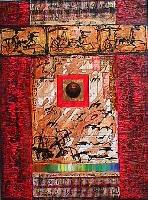 |
||||
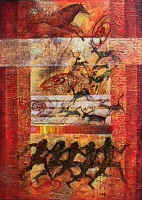 |
||||
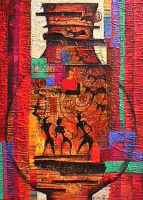 |
||||
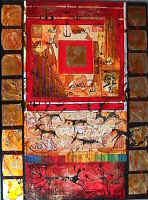 |
||||
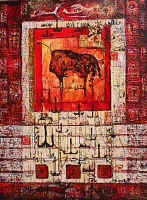 |
||||